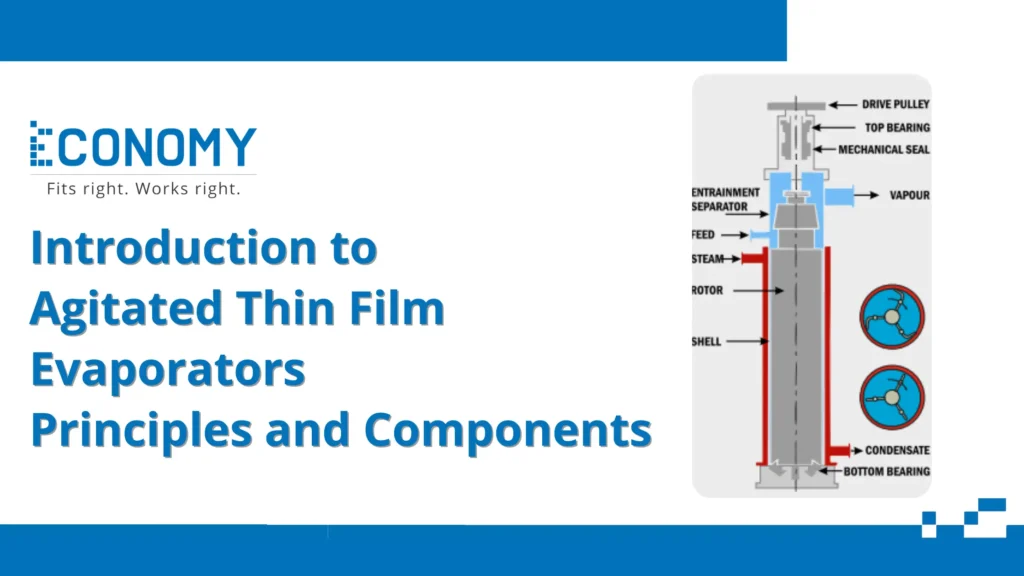Agitated Thin Film Evaporators (ATFE) are widely used in industries requiring efficient evaporation of high-viscosity, heat-sensitive, or fouling-prone materials. These evaporators offer significant advantages over conventional methods due to their unique design and operating principles. In this article, we will explore the working principle, operation, and benefits of Agitated Thin Film Evaporators to better understand their potential in industrial processes.
Working Principle of Agitated Thin Film Evaporators
The agitated thin film evaporator working principle revolves around the creation of a thin film of liquid on the inner surface of a heated cylindrical vessel. As the liquid is introduced into the evaporator, rotating blades (or agitators) spread it into a thin, turbulent film across the heat transfer surface. This thin film ensures that the liquid is evenly distributed and in close contact with the heated wall, promoting rapid evaporation of volatile components.
In an ATFE, the agitator not only spreads the liquid but also ensures continuous movement, preventing the liquid from adhering to the surface or causing fouling. This movement promotes efficient heat transfer and maintains the material in a non-stagnant state, minimizing thermal degradation. The vapor generated from the evaporation process is removed through an outlet at the top of the evaporator, while the concentrated residue or distillate is collected at the bottom.
The thin film formation and agitation are key to the efficiency of the ATFE, especially when dealing with viscous materials or substances prone to fouling. The reduced film thickness allows for quick evaporation, minimizing the heat exposure time and protecting heat-sensitive materials from degradation.
Operation of Agitated Thin Film Evaporators
The operation of an Agitated Thin Film Evaporator involves several stages, beginning with the introduction of the feed material and ending with the collection of the vapor and concentrated residue. The process can be broken down into the following steps:
- Feed Entry:
- The feed material enters the evaporator at the top, where it is immediately expose to the rotating blades of the agitator. These blades spread the feed into a thin film on the heated surface.
- Film Formation:
- As the liquid feed is distribute by the agitator, a thin film forms on the inner surface of the evaporator. This thin film allows for maximum contact with the heated surface, facilitating rapid evaporation of the volatile components.
- Agitation and Heat Transfer:
- The rotating blades maintain continuous agitation of the liquid film, ensuring that it remains evenly spread and preventing material from accumulating on the heat transfer surface. This agitation enhances heat transfer efficiency by creating turbulence within the liquid film.
- Evaporation and Vapor Collection:
- As the thin film moves downward along the heated surface, evaporation takes place. The vapor generate rises to the top of the evaporator, where it is collect and direct to a condenser or other recovery systems.
- Concentrate Collection:
- The remaining concentrate material, often referred to as the distillate or residue, is collect at the bottom of the evaporator. This material may undergo further processing or disposal, depending on the application.
ATFEs can operate under a variety of conditions, including high vacuum, which allows for evaporation at lower temperatures. This is particularly beneficial for heat-sensitive products that would otherwise degrade under high thermal stress.
Benefits of Agitated Thin Film Evaporators
Agitated Thin Film Evaporators provide several significant advantages over traditional evaporation methods. These benefits make ATFEs highly suitable for a wide range of industrial applications, particularly those involving challenging or complex materials.
- Efficient Heat Transfer:
- The creation of a thin, turbulent film promotes efficient heat transfer by increasing the surface area exposed to the heated wall. This efficient heat transfer reduces the amount of energy required for evaporation, making the process more energy-efficient.
- Handling High-Viscosity Materials:
- ATFEs are well-suite for processing highly viscous materials, which can be difficult to evaporate using conventional methods. The rotating blades effectively spread even thick materials into thin films, allowing for consistent evaporation.
- Minimized Thermal Degradation:
- Since the thin film is expose to the heat surface for only a short duration, there is less risk of thermal degradation. This is particularly important when dealing with heat-sensitive materials such as pharmaceuticals, specialty chemicals, and food products.
- Fouling Resistance:
- The continuous agitation within the evaporator prevents the buildup of material on the heat transfer surface. This resistance to fouling ensures consistent operation over extended periods, reducing the need for frequent cleaning and maintenance.
- Flexibility and Scalability:
- ATFEs are highly versatile and can be adapt to a variety of process requirements, including different feed materials, operating pressures, and temperatures. Additionally, ATFEs can be scale to accommodate both small and large production volumes, making them suitable for both pilot plants and full-scale industrial operations.
- Vacuum Operation:
- Agitated Thin Film Evaporators can operate under vacuum conditions, enabling evaporation at lower temperatures. This is particularly advantageous when processing volatile or heat-sensitive materials, as it minimizes the risk of degradation.
Conclusion
Agitated Thin Film Evaporators offer a highly efficient and versatile solution for the evaporation of challenging materials. Their working principle, based on the creation of a thin, turbulent film, ensures optimal heat transfer while minimizing the risk of fouling and thermal degradation. The operation of ATFEs is straightforward, with continuous agitation enhancing performance and extending the life of the equipment. The benefits of ATFEs—such as their ability to handle high-viscosity materials, resist fouling, and operate under vacuum—make them an indispensable tool across industries, including pharmaceuticals, chemicals, and food processing. By unlocking the potential of Agitated Thin Film Evaporators, industries can achieve more efficient and reliable evaporation processes, even with the most complex feed materials.
